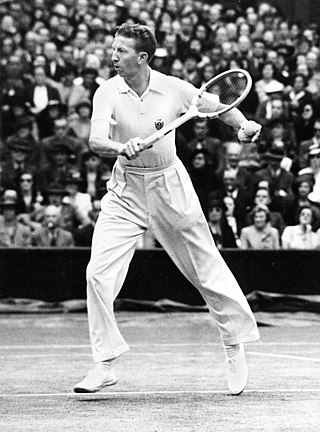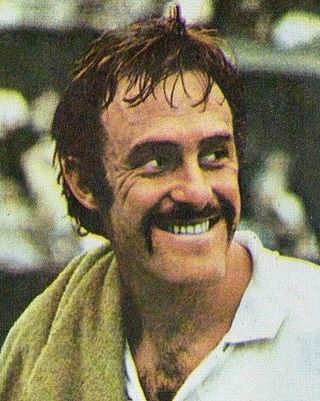The Grand Slam in tennis is the achievement of winning all four major championships in one discipline in a calendar year. In doubles, a Grand Slam may be achieved as a team or as an individual with different partners. Winning all four major championships consecutively but not within the same calendar year is referred to as a "non-calendar-year Grand Slam", while winning the four majors at any point during the course of a career is known as a "Career Grand Slam".

John Donald Budge was an American tennis player. He is most famous as the first tennis player — male or female, to win all four Grand Slam events consecutively overall. Budge was the second man to complete the career Grand Slam after Fred Perry, and remains the youngest to achieve the feat. He won ten majors, of which six were Grand Slam events and four Pro Slams, the latter achieved on three different surfaces. Budge is considered to have one of the best backhands in the history of tennis, with most observers rating it better than that of later player Ken Rosewall.

Frederick John Perry was a British tennis and table tennis player and former world No. 1 from England who won 10 Majors including eight Grand Slam tournaments and two Pro Slams single titles, as well as six Major doubles titles. Perry won three consecutive Wimbledon Championships from 1934 to 1936 and was World Amateur number one tennis player during those three years. Prior to Andy Murray in 2013, Perry was the last British player to win the men's Wimbledon championship, in 1936, and the last British player to win a men's singles Grand Slam title, until Andy Murray won the 2012 US Open.

John David Newcombe AO OBE is an Australian former professional tennis player. He is one of the few men to have attained a world No. 1 ranking in both singles and doubles. At the majors, he won seven singles titles, a former record 17 men's doubles titles, and two mixed doubles titles. He also contributed to five Davis Cup titles for Australia during an age when the Davis Cup was deemed as significant as the majors. Tennis magazine rated him the 10th best male player of the period 1965–2005.

Kenneth Robert Rosewall is an Australian former world top-ranking professional tennis player. Rosewall won 147 singles titles, including a record 15 Pro Majors and 8 Grand Slam titles for a total 23 titles at pro and amateur majors ranks him second all time to Novak Djokovic on 24. He also won 15 Pro Majors in doubles and 9 Grand Slam doubles titles. Rosewall achieved a Pro Slam in singles in 1963 by winning the three Pro Majors in one year and he completed the Career Grand Slam in doubles.

Roy Stanley Emerson is an Australian former tennis player who won 12 Grand Slam singles titles and 16 Grand Slam doubles titles, for a total of 28 Grand Slam titles. All of his singles Grand Slam victories and 14 of his Grand Slam doubles victories were achieved before the open era began in 1968. He is the only male player to have completed a career Grand Slam in both singles and doubles, and the first of four male players to complete a double career Grand Slam in singles. His 28 major titles are the all-time record for a male player. He was ranked world No. 1 amateur in 1961 by Ned Potter, 1964 by Potter, Lance Tingay and an Ulrich Kaiser panel of 14 experts and 1965 by Tingay, Joseph McCauley, Sport za Rubezhom and an Ulrich Kaiser panel of 16 experts.

Francis Arthur Sedgman is an Australian former world No. 1 tennis player. Over the course of a three-decade career, Sedgman won five Grand Slam singles tournaments as an amateur as well as 22 Grand Slam doubles tournaments. He is one of only five tennis players all-time to win multiple career Grand Slams in two disciplines, alongside Margaret Court, Roy Emerson, Martina Navratilova and Serena Williams. In 1951, he and Ken McGregor won the Grand Slam in men's doubles. Sedgman turned professional in 1953, and won the Wembley World Professional Indoor singles title in 1953 and 1958. He also won the Sydney Masters tournament in 1958, and the Melbourne Professional singles title in 1959. He won the Grand Prix de Europe Professional Tour in 1959.

John Albert Kramer was an American tennis player of the 1940s and 1950s, and a pioneer promoter who helped drive the sport towards professionalism at the elite level. Kramer also ushered in the serve-and-volley era in tennis, a playing style with which he won three Grand Slam tournaments. He also led the U.S. Davis Cup tennis team to victory in the 1946 and 1947 Davis Cup finals.

John Herbert Crawford, was an Australian tennis player during the 1930s. He was the World No. 1 amateur for 1933, during which year he won the Australian Open, the French Open, and Wimbledon, and was runner-up at the U.S. Open in five sets, thus missing the Grand Slam by one set that year. He also won the Australian Open in 1931, 1932, and 1935. He was inducted into the International Tennis Hall of Fame in 1979.

The Brisbane Bears was the name for a professional Australian rules football club based in Brisbane, Queensland. Granted a Victorian Football League license in 1986, it was the first privately owned club in the history of the competition and debuted in the 1987 VFL season.

Sir Norman Everard Brookes was an Australian tennis player. During his career he won three Grand Slam singles titles; Wimbledon in 1907 and 1914 and the Australasian Championships in 1911. Brookes was part of the Australasian Davis Cup team that won the title on six occasions. The Australian Open men's singles trophy, the Norman Brookes Challenge Cup, is named in his honour. After his active playing career Brookes became president of the Lawn Tennis Association of Australia.
World number 1 ranked male tennis players is a year-by-year listing of the male tennis players who were ranked as world No. 1 by various contemporary and modern sources. The annual source rankings from which the No. 1 players are drawn are cited for each player's name, with a summary of the most important tennis events of each year also included. If world rankings are not available, recent rankings by tennis writers for historical years are accessed, with the dates of the recent rankings identified. In the period 1948–1953, when contemporary professional world rankings were not created, the U.S. professional rankings are cited.

Rex Noel Hartwig was an Australian tennis player.
Geoffrey Edmund Brown was an Australian tennis player.
Wayne Pascoe is a former professional tennis player from Australia.
Victor Eke is a former professional tennis player from Australia.
This article presents top ten lists of male singles tennis players, as ranked by various official and non-official ranking authorities throughout the history of the sport. Rankings of U.S.-only professionals pre-Open Era, and U.S.-only amateurs during World War II are also included.
Peter Campbell is an Australian former professional tennis player. He was previously a women's coach at the Australian Institute of Sport in Canberra.
Bill Gilmour, is an Australian former tennis player of the 1950s.
Harry Aaron Brittain is an Australian-born Canadian former professional tennis player.










